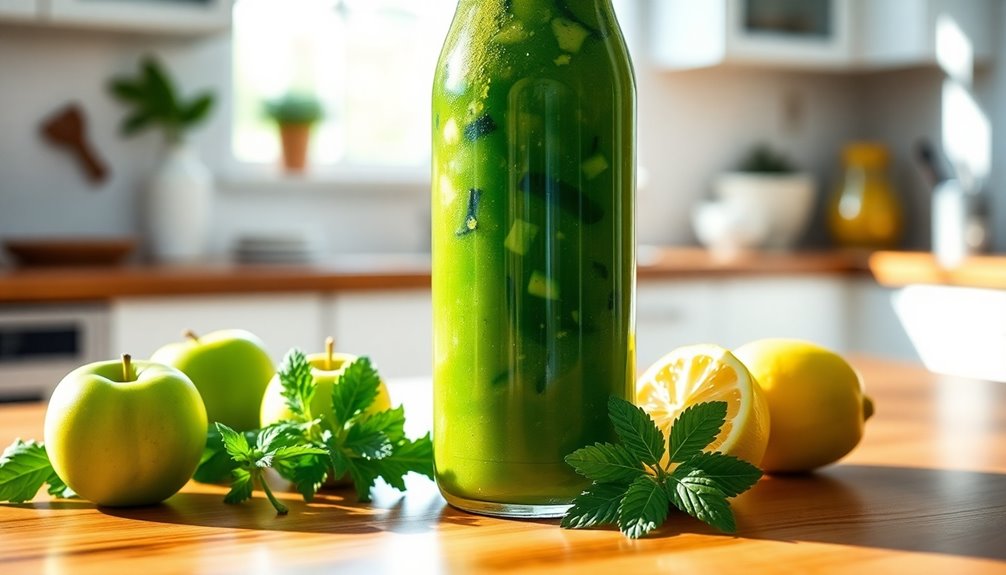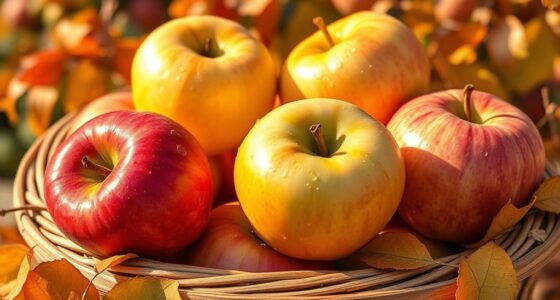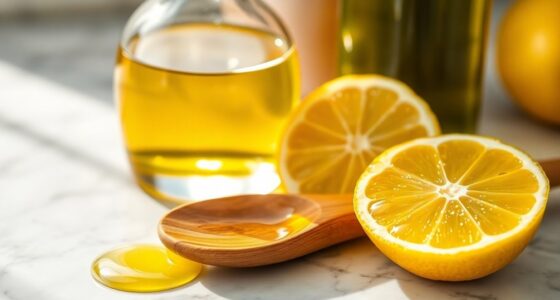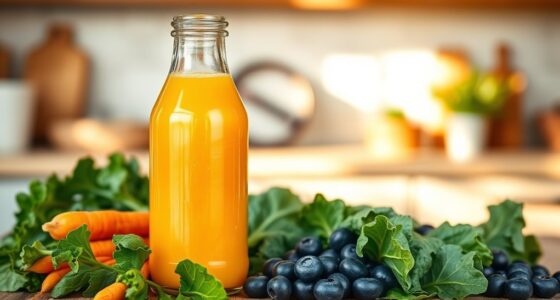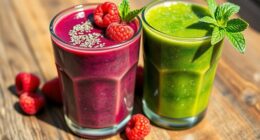Homemade green juice stays fresh for 24 to 48 hours in the fridge, but you can extend its shelf life to up to 72 hours in airtight glass containers. To maintain peak freshness, store your juice at 35-40°F (1.6-4.4°C) and avoid exposing it to light and air. Remember, ingredient choice and juicer type play crucial roles in longevity, and recognizing signs of spoilage is essential. Keep going to discover more about preserving your green juice!
Key Takeaways
- Homemade green juice typically lasts 24 to 48 hours in the fridge at peak freshness, with a maximum of 3-5 days.
- Using airtight glass containers can extend the shelf life of green juice up to 72 hours.
- Ingredient choice affects spoilage rates; leafy greens spoil faster than citrus fruits.
- Signs of spoilage include changes in color, texture, scent, and taste.
- Store juice at 35-40°F (1.6-4.4°C) in the back of the fridge for optimal freshness.
Understanding Shelf Life of Homemade Green Juice
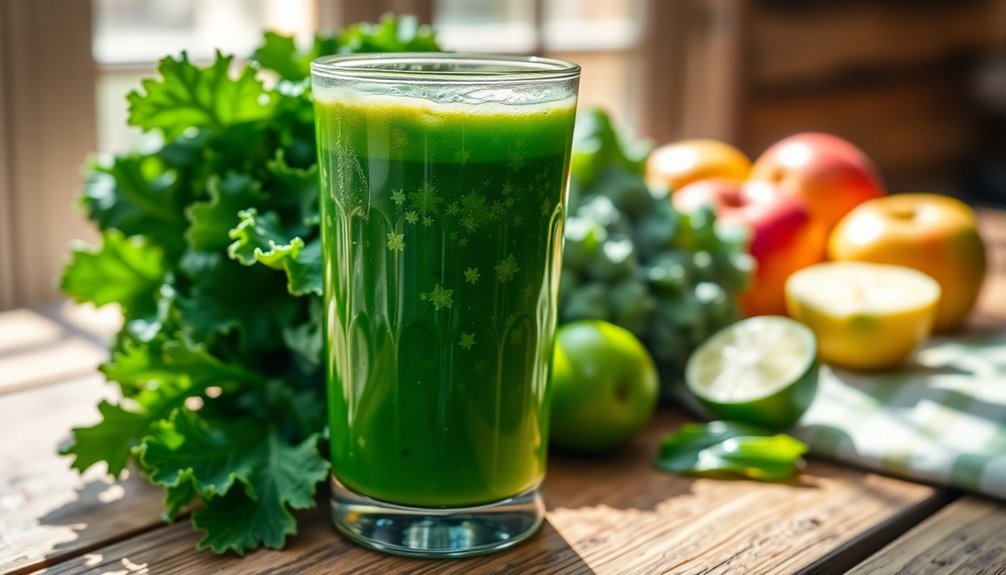
How long can you really expect your homemade green juice to last? Typically, you can enjoy it for 24 to 48 hours in the fridge while it's at its freshest and most nutritious. If you store it properly in airtight glass containers, it may last up to 72 hours. However, keep in mind that green juice has a shorter shelf life compared to other juices due to its high chlorophyll content. Cold-press juicers are recommended to preserve nutrients longer, ensuring that you get the most out of your green goodness. The sooner you consume it, the better its nutritional value remains. To really extend its life, consider vacuum sealing or freezing, but remember that frozen juice may lose some nutrients over time. Consuming green juices regularly can also support detoxification processes in the body. Always inspect for spoilage to ensure your green goodness stays safe and tasty!
Factors Influencing the Longevity of Green Juice

Several factors can significantly influence the longevity of your homemade green juice, ensuring it stays fresh and nutritious for as long as possible.
First, the ingredients you choose matter; leafy greens and root vegetables typically last 24-48 hours, while citrus fruits can help extend shelf life due to their acidity. Some ingredients spoil faster due to their composition, so it's important to consider this when selecting your produce.
The temperature you store your juice at is crucial—keeping it consistently below 40°F (4°C) slows degradation, while fluctuating temperatures speed up spoilage.
Additionally, using a cold-pressed juicer over a centrifugal one can lead to longer-lasting juice by reducing oxidation.
Lastly, the quality of your storage container plays a role; glass or airtight containers work best to minimize air exposure and maintain freshness.
Best Storage Techniques for Freshness

To keep your homemade green juice fresh and nutritious, it's essential to focus on effective storage techniques.
Use airtight glass or stainless steel containers to limit oxygen exposure and avoid plastic, which can leach harmful chemicals. For best results, store your juice at 35-40°F (1.6-4.4°C) in the back of the fridge to maintain a consistent temperature. Maximum storage time in the fridge is up to 72 hours, so plan to consume your juice within this timeframe for optimal freshness.
If refrigeration isn't available, consider using cooler bags with ice packs. When freezing, portion your juice in airtight containers, leaving space for expansion, and remember that it can last 2-3 months when stored properly.
To further enhance freshness, fill containers to the top to minimize air exposure and consider adding citrus for its natural preservative qualities.
Nutritional Considerations for Green Juice
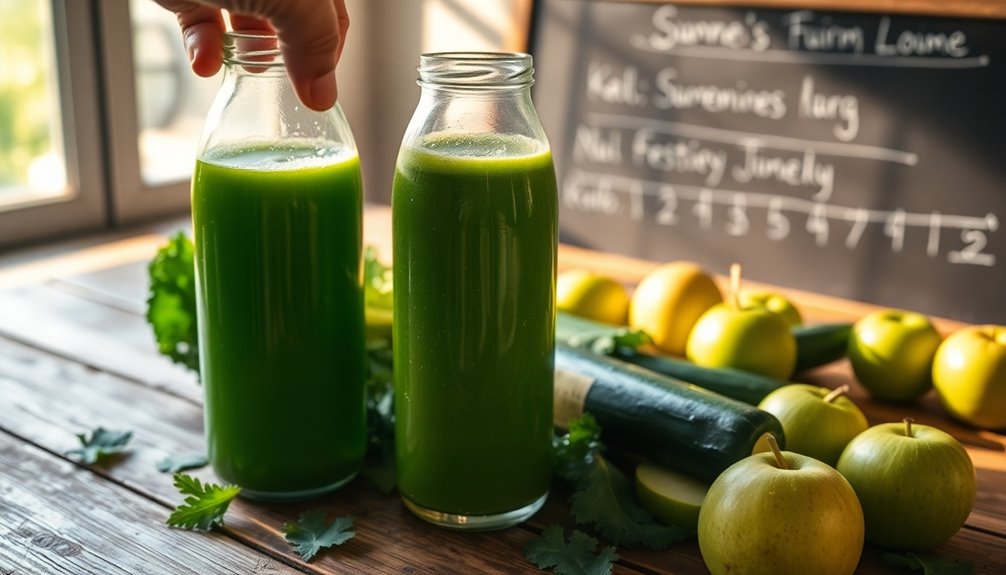
Storing your homemade green juice properly not only preserves its freshness but also maintains its nutritional value. Packed with vitamins A, C, and K, as well as minerals like iron and calcium, your green juice supports your immune system and enhances overall health. The antioxidants and phytochemicals help combat inflammation, while the high fiber content promotes digestive health. With a low-calorie count, it's an excellent choice for weight management. Plus, the liquid form allows for efficient nutrient absorption, making it easier for your body to benefit from natural vitamins. Incorporating fresh produce like kale and spinach boosts nutrient density, ensuring you get the most out of every sip. Additionally, consuming whole foods can further enhance your overall diet quality. Green juice is not just a fad; it has legitimate health advantages! Enjoy this nutritious addition to your balanced diet!
Safety and Handling of Homemade Juices
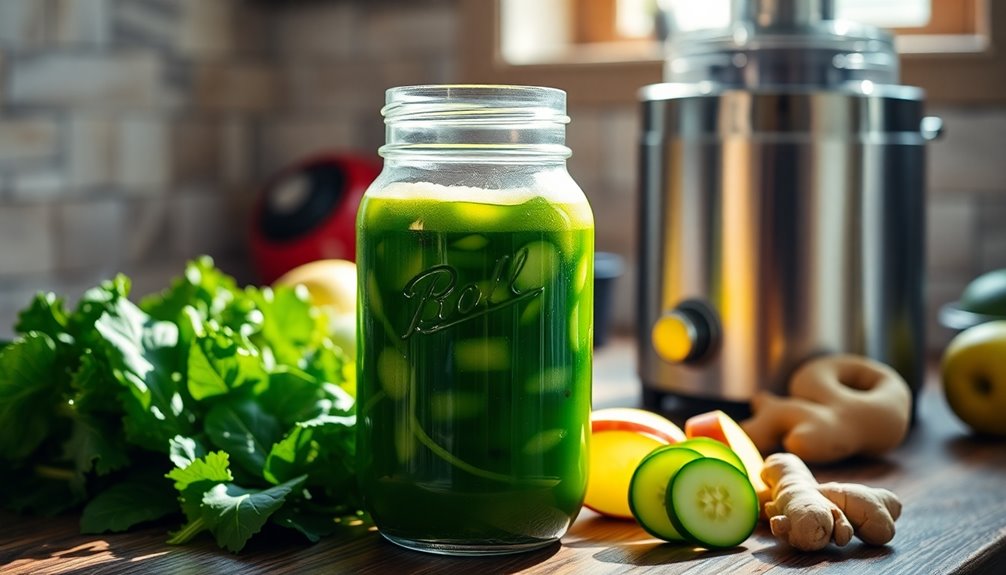
While making delicious homemade green juice can be a rewarding experience, ensuring safety and proper handling is crucial to avoid potential health risks.
Always wash your fruits and vegetables thoroughly under running water to reduce bacterial contamination. Keep your juicing equipment clean and sanitized to prevent cross-contamination. Proper juice storage techniques can help maximize nutrition and extend the freshness of your juice. Additionally, be sure to check filters on any air purifier in the vicinity, as they can influence the quality of the air you breathe while preparing your juice.
Once prepared, store your juice in the refrigerator at a consistent temperature below 40°F (4°C) to slow down bacterial growth. Unpasteurized juices carry a higher risk of contamination, so consume them within a few days, especially if you're part of a vulnerable population.
Be mindful of warning labels on untreated juices, and always inspect for signs of spoilage before drinking. Proper handling is key to enjoying your homemade green juice safely.
Tips for Maximizing Freshness
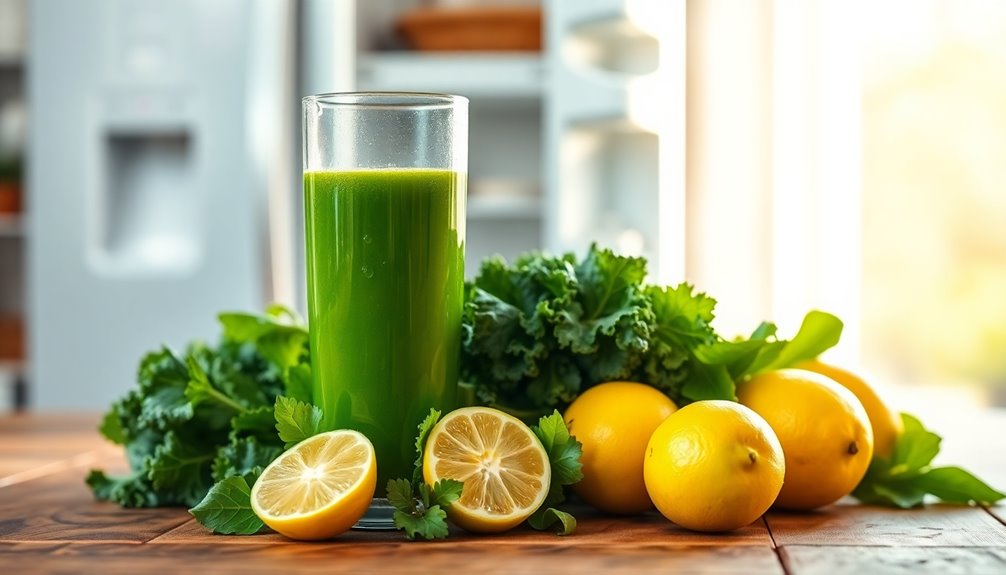
Maximizing the freshness of your homemade green juice hinges on smart storage practices.
Start by using airtight glass containers to minimize air exposure and preserve nutrients. Fill those containers to the brim to limit oxidation and spoilage. Since cold pressed raw juice typically lasts 3 to 7 days, it's essential to consume your juice within this timeframe for optimal freshness.
Store your juice in dark areas of the fridge, protecting it from light that can degrade nutrients. Maintain a consistent fridge temperature at or below 40°F (4°C) to slow down degradation.
Don't forget to label your containers with dates, helping you keep track of freshness.
These simple steps will help ensure your green juice stays flavorful and nutritious for as long as possible, allowing you to enjoy every sip!
The Impact of Juicer Type on Shelf Life

The type of juicer you choose plays a crucial role in determining how long your homemade green juice will stay fresh.
Centrifugal juicers, while quick, introduce more oxygen, leading to oxidation and a shelf life of just 24 hours in the fridge.
Masticating juicers, on the other hand, slow down the extraction process, allowing your juice to last up to 72 hours. Fresh juice lasts 24-72 hours when stored properly in the refrigerator. This longer shelf life is due to the reduced oxidation that occurs during the juicing process, preserving the nutrients and flavor. To maximize freshness, it’s essential to know how to store homemade orange juice correctly. Always use airtight containers and keep the juice refrigerated to maintain its quality for the longest possible duration.
If you opt for a cold press juicer, you can extend that freshness to about 5 days thanks to minimal heat and air exposure.
Twin gear juicers further reduce oxidation, enhancing shelf life beyond standard masticating models.
Importance of Temperature Control
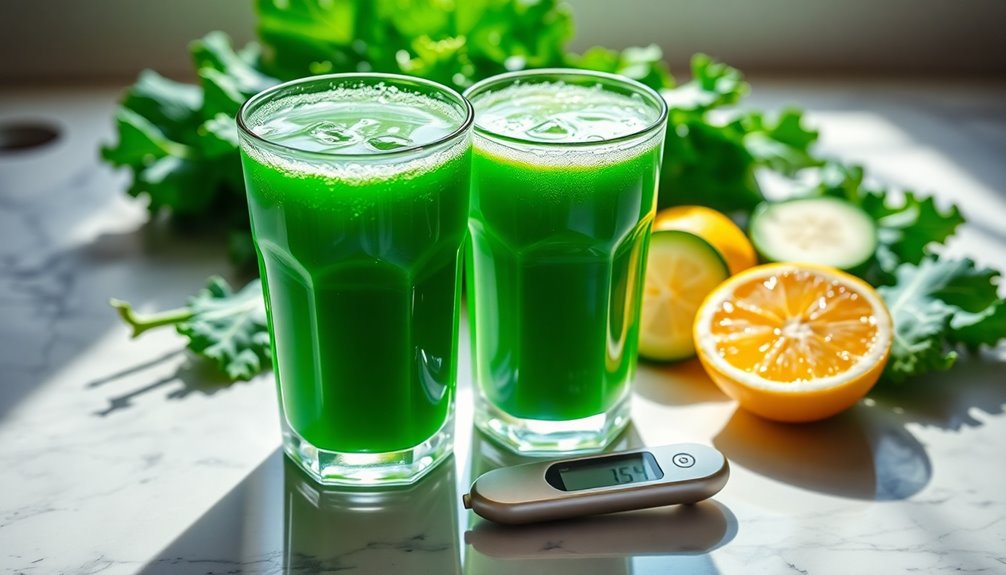
Choosing the right juicer is just the start; how you store your homemade green juice is equally important. You need to keep it out of the temperature danger zone, which is between 40°F and 140°F, where bacteria double every 20 minutes.
Ideally, refrigerate your juice at 34-40°F to maintain freshness and safety. Consistency in temperature slows bacterial growth, so check your fridge's efficiency regularly. Homemade juice typically lasts 3-5 days in the fridge, so be mindful of how long it has been stored.
If you want to extend shelf life, consider freezing your juice at 0°F or below. Remember, storing juice on the central shelves is better than the door, where fluctuations occur.
Immediate refrigeration after preparation is key, as warmth can lead to nutrient loss and spoilage. Keep it cool, and your juice will stay fresh longer!
Recognizing Signs of Spoilage in Green Juice

How can you tell if your homemade green juice has gone bad? Start by checking the color; fresh juice should be vibrant green. If you notice it turning brown or murky, that's a sign of oxidation and spoilage.
Next, look at the texture. Smooth juice is ideal, while a chunky or slimy texture indicates bacterial growth. Don't forget to give it a smell; a fresh, earthy scent is what you want—sour or fermented odors signal it's time to toss it. Additionally, remember that proper storage conditions are essential for maintaining freshness, so ensure your juice is kept at or below 41° F (5° C).
Finally, take a sip. If the taste is sharp or bitter, it's likely spoiled. Regularly inspecting your juice for these signs helps ensure you enjoy the freshest flavors.
Frequently Asked Questions
Can I Mix Different Types of Green Juices for Better Flavor?
Absolutely, you can mix different types of green juices for better flavor! By combining greens like kale and spinach, you create a more complex taste.
Adding fruits like apples can balance bitterness, while herbs like parsley add freshness.
Don't forget to experiment with spices like ginger for an extra kick. Mixing also boosts nutrient diversity, keeping your juices interesting and tailored to your preferences.
Just remember to use fresh ingredients for the best results!
What Are the Best Ingredients for Maximizing Shelf Life?
Did you know that adding lemon juice can increase the shelf life of your homemade juice by up to 3 days?
To maximize freshness, you should include high-acid ingredients like citrus fruits or ginger, which help preserve flavor and quality.
Store your juice in airtight glass containers and keep it in the back of the fridge at a consistent temperature.
This way, you'll enjoy your green juice longer and savor its nutrients!
How Does the Juicing Method Affect Taste?
The juicing method you choose significantly impacts taste. If you use a centrifugal juicer, you might find your juice has a less vibrant flavor due to heat and oxidation.
On the other hand, cold-press juicers preserve more nutrients and deliver a richer taste. The quality of your ingredients also matters—fresh, high-quality produce enhances flavor.
Can I Add Preservatives to Homemade Green Juice?
Yes, you can add preservatives to homemade green juice! Think of them as your juice's protective shield, extending freshness and enhancing flavor.
Natural options like ascorbic acid and honey help prevent browning and maintain nutrients.
Just remember, moderation is key—using too much can pose health risks.
Is It Safe to Consume Juice After Its Expiration Date?
It's not always unsafe to consume juice after its expiration date, but you should be cautious.
Expiration dates mainly help retailers manage inventory. If the juice is pasteurized, it's usually safer to drink even past that date.
However, avoid cold-pressed juices after expiration, as they can spoil quickly.
Always check for spoilage signs like off smells or mold before drinking, and when in doubt, it's better to discard the juice.
Conclusion
In a nutshell, homemade green juice is a vibrant burst of nutrition, but its freshness doesn't last forever. By storing it properly and keeping an eye on factors like temperature and juicer type, you can savor your green goodness for longer. Remember, a little care goes a long way—like a well-tended garden, your juice thrives when given the right conditions. So, enjoy your creations while they're at their peak, and drink up the health benefits!
Cindy thoroughly researches juicing trends, techniques, and recipes to provide readers with practical advice and inspiration. Her writing style is accessible, engaging, and designed to make complex concepts easy to understand. Cindy’s dedication to promoting the advantages of juicing shines through her work, empowering readers to make positive changes in their lives through the simple act of juicing.

